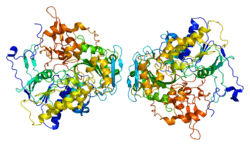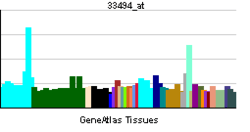ETFDH
| View/Edit Human | View/Edit Mouse |
Electron transfer flavoprotein-ubiquinone oxidoreductase, mitochondrial is an enzyme that in humans is encoded by the ETFDH gene.[3]
Electron-transferring-flavoprotein dehydrogenase in the inner mitochondrial membrane accepts electrons from electron-transfer flavoprotein which is located in the mitochondrial matrix and reduces ubiquinone in the mitochondrial membrane. The protein is synthesized as a 67-kDa precursor which is targeted to mitochondria and processed in a single step to a 64-kDa mature form located in the mitochondrial membrane. Deficiency in electron-transferring-flavoprotein dehydrogenase have been demonstrated in some patients with type II glutaricacidemia.[3]
References
Further reading
- Olsen RK, Olpin SE, Andresen BS, et al. (2007). "ETFDH mutations as a major cause of riboflavin-responsive multiple acyl-CoA dehydrogenation deficiency.". Brain. 130 (Pt 8): 2045–54. doi:10.1093/brain/awm135. PMID 17584774.
- Gempel K, Topaloglu H, Talim B, et al. (2007). "The myopathic form of coenzyme Q10 deficiency is caused by mutations in the electron-transferring-flavoprotein dehydrogenase (ETFDH) gene.". Brain. 130 (Pt 8): 2037–44. doi:10.1093/brain/awm054. PMID 17412732.
- Kimura K, Wakamatsu A, Suzuki Y, et al. (2006). "Diversification of transcriptional modulation: large-scale identification and characterization of putative alternative promoters of human genes.". Genome Res. 16 (1): 55–65. doi:10.1101/gr.4039406. PMC 1356129
 . PMID 16344560.
. PMID 16344560. - Gerhard DS, Wagner L, Feingold EA, et al. (2004). "The status, quality, and expansion of the NIH full-length cDNA project: the Mammalian Gene Collection (MGC).". Genome Res. 14 (10B): 2121–7. doi:10.1101/gr.2596504. PMC 528928
 . PMID 15489334.
. PMID 15489334. - Olsen RK, Andresen BS, Christensen E, et al. (2003). "Clear relationship between ETF/ETFDH genotype and phenotype in patients with multiple acyl-CoA dehydrogenation deficiency.". Hum. Mutat. 22 (1): 12–23. doi:10.1002/humu.10226. PMID 12815589.
- Strausberg RL, Feingold EA, Grouse LH, et al. (2003). "Generation and initial analysis of more than 15,000 full-length human and mouse cDNA sequences.". Proc. Natl. Acad. Sci. U.S.A. 99 (26): 16899–903. doi:10.1073/pnas.242603899. PMC 139241
 . PMID 12477932.
. PMID 12477932. - Goodman SI, Binard RJ, Woontner MR, Frerman FE (2003). "Glutaric acidemia type II: gene structure and mutations of the electron transfer flavoprotein:ubiquinone oxidoreductase (ETF:QO) gene.". Mol. Genet. Metab. 77 (1–2): 86–90. doi:10.1016/S1096-7192(02)00138-5. PMID 12359134.
- Simkovic M, Degala GD, Eaton SS, Frerman FE (2002). "Expression of human electron transfer flavoprotein-ubiquinone oxidoreductase from a baculovirus vector: kinetic and spectral characterization of the human protein". Biochem. J. 364 (Pt 3): 659–67. doi:10.1042/BJ20020042. PMC 1222614
 . PMID 12049629.
. PMID 12049629. - White RA, Dowler LL, Angeloni SV, Koeller DM (1996). "Assignment of Etfdh, Etfb, and Etfa to chromosomes 3, 7, and 13: the mouse homologs of genes responsible for glutaric acidemia type II in human". Genomics. 33 (1): 131–4. doi:10.1006/geno.1996.0170. PMID 8617498.
- Goodman SI, Axtell KM, Bindoff LA, et al. (1994). "Molecular cloning and expression of a cDNA encoding human electron transfer flavoprotein-ubiquinone oxidoreductase". Eur. J. Biochem. 219 (1–2): 277–86. doi:10.1111/j.1432-1033.1994.tb19939.x. PMID 8306995.
This article is issued from Wikipedia - version of the 6/6/2016. The text is available under the Creative Commons Attribution/Share Alike but additional terms may apply for the media files.




